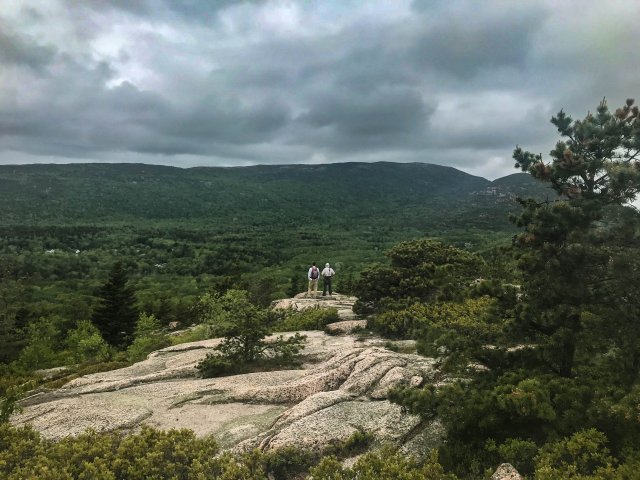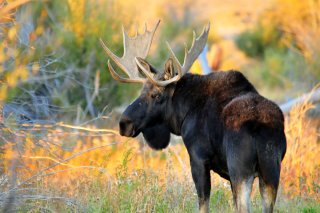Climate Change Connections: Maine (Forests and Outdoor Recreation)
Climate change is impacting all regions and sectors of the United States. The State and Regional Climate Change Connections resource highlights climate change connections to culturally, ecologically, or economically important features of each state and territory. The content on this page provides an illustrative example. As climate change will affect each state and territory in diverse ways, this resource only describes a small portion of these risks. For more comprehensive information about regional climate impacts, please visit the Fifth National Climate Assessment and Climate Change Impacts by Sector.
On this page:
Introduction: Maine Is a Destination for Outdoor Recreation

With its rocky coastline, serene forests, blueberry fields, and mountains, Maine is known for its natural beauty. Nearly 89 percent of the state is covered by forest—the highest percentage of any state.1 These estimated 17.5 million acres include balsam fir, red spruce, pines, and other trees and ground cover that provide habitat for deer, moose, black bears, and many more species.1 Maine’s trails and parks are popular destinations for hikers and others who enjoy the outdoors. The outdoor recreation industry is a critical component of the state’s economy and supports thousands of jobs.2 Protected areas like Acadia National Park draw millions of visitors annually. In 2022, visitors to Acadia National Park spent over $470 million and supported thousands of jobs, boosting the local economy.3 Maine’s vast forests also play a significant role in absorbing and storing carbon from the atmosphere, making them an important buffer against climate change by mitigating the effects of greenhouse gas emissions.4,5
Climate Impacts: Warming Temperatures Create Favorable Conditions for Ticks
Warming from climate change threatens outdoor recreation and forest ecosystems in Maine by increasing the habitat range of ticks and likelihood of exposure to tick-borne illness.6 The deer tick (Ixodes scapularis) lives at the edges of wooded areas and is active for most of the year.7 This species is the primary vector in the Northeast for Lyme disease, the most common tick-borne illness in the United States.8 When deer ticks carrying the bacteria that causes Lyme disease bite humans, they can transmit Lyme disease. This infection can cause rash, fever, headache, fatigue, arthritis, heart inflammation, and other serious health effects.9 Rates of tick-borne diseases will likely continue to increase as winters become warmer and shorter and prey habitats change, allowing ticks to thrive for longer and spread into new areas.10,11

The Northeast has seen a rise in tick-borne illness due to warmer, shorter winters, longer warm seasons, and changes in precipitation.12 Deer ticks prefer temperatures over 45°F and at least 85 percent humidity.11 As temperatures warm, adult ticks can feed longer each year and produce more offspring. Warm, humid temperatures also favor tick larvae, which is the primary life stage responsible for transmitting the bacteria to humans and other animals. As tick populations increase due to these factors, so does the likelihood of encountering them12 —making this a worrisome trend for outdoor enthusiasts.
Ticks are also extending their season earlier into the spring. According to climate projections, the high-risk period for Lyme disease in the Northeast will start up to 2.3 weeks earlier as soon as 2065.10,13 While low winter temperatures and drier days once curbed tick survival, a changing Maine climate with higher relative humidity, hotter days, and more frequent stretches of warm days may lead to the expansion of both seasonal activity and the northern range for tick species.12
Warming Temperatures Affect Forests and Wildlife
Warming temperatures can threaten the forests and wildlife that make Maine unique. Warming temperatures can aid the spread of invasive plants, which can outcompete native species and disrupt ecosystems.14 Warmer winters also can increase the number of pests that harm forests and the likelihood of pest survival.14 Warming temperatures may also allow tree-damaging pests such as the hemlock woolly adelgid and pine bark beetle to expand north.5 Meanwhile, Maine forests face threats from invasive species such as the emerald ash borer, a destructive wood-boring insect that can kill ash trees—a commercially, culturally, and ecologically important tree species in Maine.15

Warmer winters and drier summers could cause heat-related harm to plants, impacting forest ecosystem health. For example, forests in Acadia National Park are nearly 40 percent red spruce, which thrive in cold climates but may not tolerate a warmer climate. Warming temperatures and changing precipitation patterns could have major implications for the habitat and species that depend on spruce.16
Moose are another iconic Maine species threatened by warmer temperatures and the spread of ticks. After only Alaska, Maine has the second-largest moose population in the United States.17 But as temperatures warm, resulting in shorter winters, winter ticks (Dermacentor albipictus) can thrive and affect moose populations. Winter ticks latch on to moose in huge numbers, with some moose carrying tens of thousands of ticks. These ticks increase mortality among moose calves and stress adult moose, leading to blood loss, hair loss, and even death.15,18
Taking Action: Managing Risk in a Changing Climate
Addressing climate change requires reducing greenhouse gas emissions while preparing for and protecting against current and future climate impacts. Communities, public officials, and individuals in every part of the United States can continue to explore and implement climate adaptation and mitigation measures. In Maine, natural resource managers, public health officials, and many others are taking steps to protect people, wildlife, and forests in a changing climate, including:
- Public health outreach. Spreading public awareness about the need for insect repellent, long pants and sleeves, tick checks, and other tick-prevention measures for outdoor enthusiasts is an important step in adapting to the changing climate.19 The Maine Center for Disease Control and Prevention has developed tick preparedness lessons for schools to raise awareness about tick safety from an early age.20,21
- Adaptative forest management. Preserving healthy forests has long been a priority in Maine. The Maine Department of Agriculture, Conservation, and Forestry Initiatives, along with the Healthy Forest Program and Invasive Species Program, gives landowners and community members the tools to act as stewards of forest resources.22 State climate plans highlight the need to monitor forests to understand changes and identify management priorities.5
To learn more about climate change impacts in Maine and the Northeast region, see Chapter 21 of the Fifth National Climate Assessment.
Related Resources
- EPA Climate Change Indicators: Lyme Disease
- Maine State Climate Summary 2022 (NOAA)
- Fifth National Climate Assessment: Chapter 7. Forests (U.S. Global Change Research Program)
- Fifth National Climate Assessment: Chapter 15. Human Health (U.S. Global Change Research Program)
- Tickborne Diseases of the United States (Centers for Disease Control and Prevention)
- Impacts of Climate Change Across Maine (Maine Climate Council)
- Maine Climate Plan (Maine Climate Council)
- Scientific Assessment of Climate Change and Its Effects in Maine (Maine Climate Council) (pdf) (35.4 MB)
References
1 Maine Department of Agriculture, Conservation & Forestry, Forest Service. (2022). 2022 Maine forest health highlights. https://www.fs.usda.gov/foresthealth/docs/fhh/ME_FHH_2022.pdf
2 Maine Department of Economic & Community Development. (n.d.). Outdoor recreation. Domestic Trade. Retrieved December 11, 2023, from https://www.maine.gov/decd/domestic-trade/target-industries/outdoor-recreation
3 Flyr, M., & Koontz, L. (2023). 2022 National Park Service visitor spending effects (Natural Resource Report NPS/NRSS/EQD/NRR—2023/2551). National Park Service, Environmental Quality Division. https://www.nps.gov/subjects/socialscience/vse.htm
4 National Park Service. (n.d.). Forests. Acadia National Park. Retrieved February 23, 2024, from https://www.nps.gov/acad/learn/nature/forests.htm
5 Maine Climate Council Scientific and Technical Subcommittee. (2020). Scientific assessment of climate change and its effects in Maine. https://www.maine.gov/future/sites/maine.gov.future/files/inline-files/GOPIF_STS_REPORT_092320.pdf
6 Maine Climate Council. (2020). Maine won’t wait: A four-year plan for climate action. https://www.maine.gov/climateplan/sites/maine.gov.climateplan/files/inline-files/MaineWontWait_December2020_printable_12.1.20.pdf
7 Lubelczyk, C. B., Elias, S. P., Rand, P. W., Holman, M. S., Lacombe, E. H., & Smith, Jr., R. P. (2004). Habitat associations of Ixodes scapularis (Acari: Ixodidae) in Maine. Environmental Entomology, 33(4), 900–906. https://doi.org/10.1603/0046-225X-33.4.900
8 Eisen, R. J., Eisen, L., & Beard, C. B. (2016). County-scale distribution of Ixodes scapularis and Ixodes pacificus (Acari: Ixodidae) in the continental United States. Journal of Medical Entomology, 53(2). https://doi.org/10.1093/jme/tjv237
9 Centers for Disease Control and Prevention. (2021). Signs and symptoms of untreated Lyme disease. Lyme Disease. Retrieved July 12, 2023, from https://www.cdc.gov/lyme/signs-symptoms/index.html
10 Yang, H., Gould, C. A., Jones, R., St. Juliana, A., Sarofim, M., Rissing, M., & Hahn, M. B. (2024). By-degree health and economic impacts of Lyme disease, eastern and midwestern United States. EcoHealth, 21, 56–70. https://doi.org/10.1007/s10393-024-01676-9
11 EPA. (2023). Climate change indicators: Lyme disease. Retrieved June 21, 2023, from https://www.epa.gov/climate-indicators/climate-change-indicators-lyme-disease
12 Hayden, M. H., Schramm, P. J., Beard, C. B., Bell, J. E., Bernstein, A. S., Bieniek-Tobasco, A., Cooley, N., Diuk-Wasser, M., Dorsey, M. K., Ebi, K. L., Ernst, K. C., Gorris, M. E., Howe, P. D., Khan, A. S., Lefthand-Begay, C., Maldonado, J., Saha, S., Shafiei, F., Vaidyanathan, A., & Wilhelmi, O. V. (2023). Ch. 15. Human health. In A. R. Crimmins, C. W. Avery, D. R. Easterling, K. E. Kunkel, B. C. Stewart, & T. K. Maycock (Eds.), Fifth National Climate Assessment. U.S. Global Change Research Program. https://doi.org/10.7930/NCA5.2023.CH15
13 Monaghan, A. J., Moore, S. M., Sampson, K. M., Beard, C. B., & Eisen, R. J. (2015). Climate change influences on the annual onset of Lyme disease in the United States. Ticks and Tick-Borne Diseases, 6(5), 615–622. https://doi.org/10.1016/j.ttbdis.2015.05.005
14 McElwee, P. D., Carter, S. L., Hyde, K. J. W., West, J. M., Akamani, K., Babson, A. L., Bowser, G., Bradford, J. B., Costanza, J. K., Crimmins, T. M., Goslee, S. C., Hamilton, S. K., Helmuth, B., Hoagland, S., Hoover, F.-A. E., Hunsicker, M. E., Kashuba, R., Moore, S. A., Muñoz, R. C., … Wilkening, J. L. (2023). Ch. 8. Ecosystems, ecosystem services, and biodiversity. In A. R. Crimmins, C. W. Avery, D. R. Easterling, K. E. Kunkel, B. C. Stewart, & T. K. Maycock (Eds.), Fifth National Climate Assessment. U.S. Global Change Research Program. https://doi.org/10.7930/NCA5.2023.CH8
15 Whitehead, J. C., Mecray, E. L., Lane, E. D., Kerr, L., Finucane, M. L., Reidmiller, D. R., Bove, M. C., Montalto, F. A., O’Rourke, S., Zarrilli, D. A., Chigbu, P., Thornbrugh, C. C., Curchitser, E. N., Hunter, J. G., & Law, K. (2023). Ch. 21. Northeast. In A. R. Crimmins, C. W. Avery, D. R. Easterling, K. E. Kunkel, B. C. Stewart, & T. K. Maycock (Eds.), Fifth National Climate Assessment. U.S. Global Change Research Program. https://doi.org/10.7930/NCA5.2023.CH21
16 National Park Service. (n.d.). Climate change. Acadia National Park. Retrieved February 23, 2024, from https://www.nps.gov/acad/learn/nature/climate-change.htm
17 Maine Department of Inland Fisheries & Wildlife. (n.d.). Moose: Alces alces americana. Retrieved June 20, 2024, from https://www.maine.gov/ifw/fish-wildlife/wildlife/species-information/mammals/moose.html
18 Ellingwood, D. D., Pekins, P. J., Jones, H., & Musante, A. R. (2020). Evaluating moose Alces alces population response to infestation level of winter ticks Dermacentor albipictus. Wildlife Biology, 2020(2). https://doi.org/10.2981/wlb.00619
19 Centers for Disease Control and Prevention. (2024). Preventing tick bites. Retrieved June 20, 2024, from https://www.cdc.gov/ticks/prevention/index.html
20 Maine Center for Disease Control & Prevention. (n.d.). Tick prevention and property management. Division of Disease Surveillance. Retrieved December 11, 2023, from https://www.maine.gov/dhhs/mecdc/infectious-disease/epi/vector-borne/lyme/tick-prevention-and-property-management.shtml
21 Maine Center for Disease Control & Prevention. (2024). Vectorborne school curricula. Retrieved June 20, 2024, from https://www.maine.gov/dhhs/mecdc/infectious-disease/epi/school-curriculum/index.shtml
22 Maine Department of Agriculture, Conservation & Forestry. (n.d.). Maine’s Healthy Forests Program. Maine Forest Service. Retrieved February 23, 2024, from https://www.maine.gov/dacf/mfs/projects/healthy_forests/index.html

